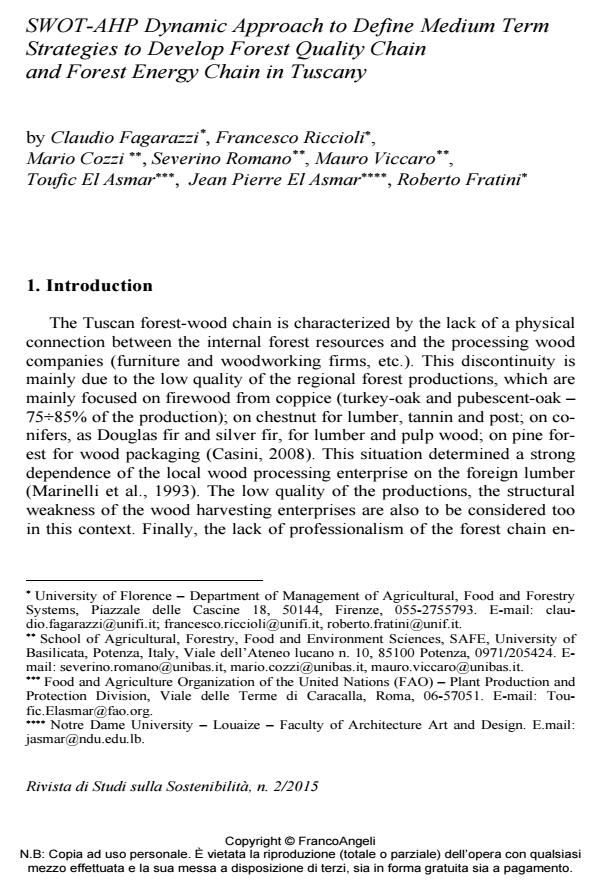SWOT-AHP Dynamic Approach to Define Medium Term Strategies to Develop Forest Quality Chain and Forest Energy Chain in Tuscany
Journal title RIVISTA DI STUDI SULLA SOSTENIBILITA'
Author/s Claudio Fagarazzi, Francesco Riccioli, Mario Cozzi, Severino Romano, Mauro Viccaro, Toufic El Asmar, Jean Pierre El Asmar, Roberto Fratini
Publishing Year 2015 Issue 2015/2
Language English Pages 18 P. 113-130 File size 251 KB
DOI 10.3280/RISS2015-002010
DOI is like a bar code for intellectual property: to have more infomation
click here
Below, you can see the article first page
If you want to buy this article in PDF format, you can do it, following the instructions to buy download credits

FrancoAngeli is member of Publishers International Linking Association, Inc (PILA), a not-for-profit association which run the CrossRef service enabling links to and from online scholarly content.
The aim of the study is directed to define medium-long term political strategies that focus on the qualitative and quantitative improvement of the Tuscany wood productions, at the same time guaranteeing a profitability to the forest workers , as well as revitalization of the quality woods productions. The proposal approach is based on a dynamic SWOT-AHP analysis: the criteria of the analysis have been examined considering three different situations: the existing one, medium and long term scenarios. This integrated application led to the definition of extremely efficacious strategic analyses. In this case the formalization through a dynamic model, able to quantify the relevance of each component, gives to the final beneficiaries an exhaustive tool for territorial planning.
Keywords: Dynamic SWOT, AHP analysis, wood production, participatory approach, governance of forest, forest chain
- New Metropolitan Perspectives Ivana Bassi, Matteo Carzedda, Luca Iseppi, Federico Nassivera, pp.21 (ISBN:978-3-030-48278-7)
- Strategic Assessment and Economic Evaluation: The Case Study of Yanzhou Island (China) Marta Bottero, Elena Comino, Federico Dell’Anna, Laura Dominici, Maurizio Rosso, in Sustainability /2019 pp.1076
DOI: 10.3390/su11041076
Claudio Fagarazzi, Francesco Riccioli, Mario Cozzi, Severino Romano, Mauro Viccaro, Toufic El Asmar, Jean Pierre El Asmar, Roberto Fratini, SWOT-AHP Dynamic Approach to Define Medium Term Strategies to Develop Forest Quality Chain and Forest Energy Chain in Tuscany in "RIVISTA DI STUDI SULLA SOSTENIBILITA'" 2/2015, pp 113-130, DOI: 10.3280/RISS2015-002010